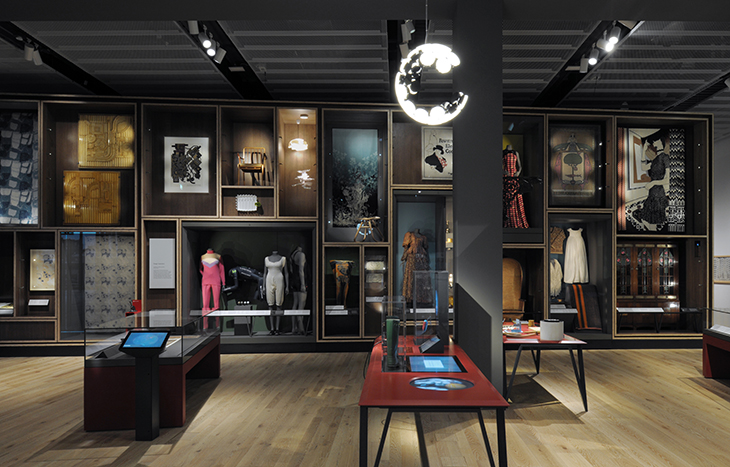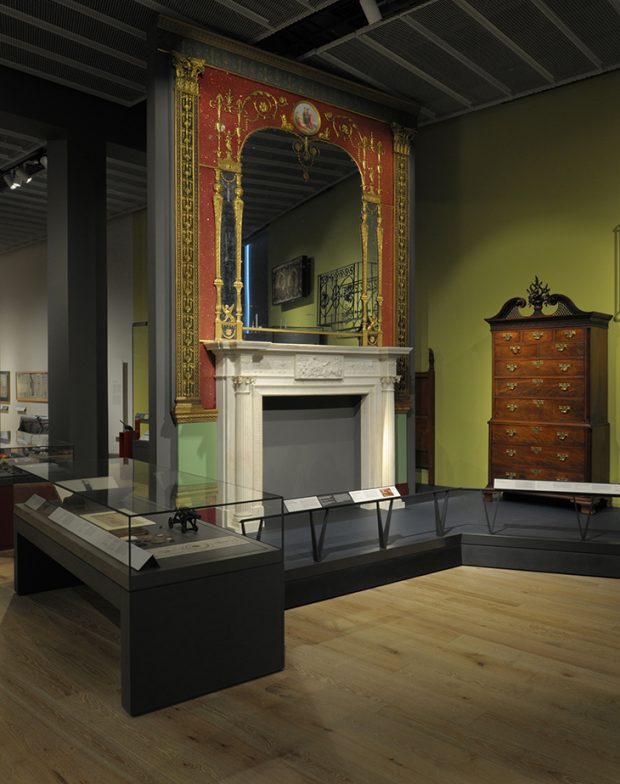When John McGrath’s play The Cheviot, The Stag and the Black, Black Oil was first performed in Aberdeen in 1973, it was hailed as a landmark in modern Scottish theatre. It paved the way for a new treatment of history and of fiction, with its experimental fusion of the two through archival source materials, reportage, Gaelic folksong and black comedy. It progresses from the Battle of Culloden to the 1970s – a bleak story, all told, but conveyed with humour and compassion for the traditions and character of the people it represents. ‘I have heard the story of my people told with truth,’ one audience member told the Scotsman. ‘If I die tonight, I die a happier man.’
These words reappear at a pivotal moment in the Scottish Design Galleries at the new V&A Dundee. As the display of ‘Design and Society’ gives way to ‘Design and the Imagination’, they are printed in front of John Byrne’s original stage set for the production. It takes the form of a giant pop-up book, with five painted backdrops rising to two metres tall, which were changed between scenes with a turn of the pages. What gives the words new heft is the impression that they have been knowingly appropriated by the new museum, as a sort of slogan for itself.

Installation view of the Scottish Design Galleries at the V&A Dundee. Courtesy ZMMA Architects; © David Grandorge
The V&A Dundee opens to the public on 15 September, after an 11-year gestation. Much has been made of the museum as a form of culture-led regeneration for this post-industrial city on Scotland’s east coast – though this isn’t to say that the place is a beacon in the desert. Dundee has been growing in self-confidence over the past decade, largely as a result of its role as a centre for innovative new design. The museum, the first in Scotland dedicated to design, has been developed in collaboration between the V&A in London, the local council, and both of Dundee’s universities. The aim has partly been to extend an understanding of good design beyond the tech start-ups and textile workshops to the wider Dundonian populace.
A visit to the museum reveals that its ambitions go much further. There is a keener political edge – one which has been underlined quite explicitly by Tristram Hunt, director of the V&A in London, who posits the museum as a corrective to ‘inward-looking, parochial nationalism’. In effect, the museum comes asserting a specific national story, familiar in Scotland from the independence referendum. The image projected is at once local and global, rooted in Scotland and Dundee while maintaining a cosmopolitan outlook. One feels this everywhere – it’s there in Kengo Kuma’s architecture, with the mighty blocks of pre-cast concrete of the exterior nodding to the cliffs of Scotland’s east coast; while the building suggests the form of a great ship that might set sail down to Tay to the North Sea and beyond. And it is with this ambition in mind that the approach to history that has been taken in the Scottish Design Galleries, which comprise the museum’s permanent collection, is best understood.
In the first gallery the objects that greet you range from a svelte Harris Tweed blazer, to the oak hulls of model ships, to a video screen on which the game ‘Lemmings’ (1991) is displayed. Each cluster of objects in the first room continues to shift your sense of where you are in time – the room is crowned with a gigantic sort of Wunderkammer in which grooved, ceiling-panels by Eduardo Paolozzi appear close to sleek lycra cycling-suits. Adam Zombory-Moldovan, of ZMMA Architects who have designed the interior of the galleries, suggests to me that perhaps the best way to orient yourself here is to think of this gallery geographically, rather than temporally – to think of it as a kind of ‘archipelago of object clusters’, which you navigate by following wherever your inclination leads you.

Installation view of the Scottish Design Galleries at the V&A Dundee. Photo: courtesy ZMMA Architects; © David Grandgorge
It’s only when you linger at a vitrine or at a cabinet, that you begin to realise that the groups of objects enable you to shape chapters of Scottish history. One section, entitled ‘Design and Identity’, takes the viewer in the course of 15 objects from Jacobite memorabilia – silver pistols, swords, a shield, and a collection of crystal goblets engraved with Jacobite texts and the face of Bonnie Prince Charlie – through to the picture-postcard version of this image of Scotland that was cemented in the writings of Walter Scott, and is represented here by an early 20th-century mirror designed by ‘MacKinlay’s Scottish Whiskies’ and decorated with a kitsch stag. Directly opposite is a section of Robert Adam’s Glass Drawing Room for Northumberland House – a sumptuous neoclassical fireplace, surmounted by a large mirror and glittering red-and-green foil panels.
As the rustic vies with the refined, the picture that gradually emerges is of a national design history that can’t be corralled beneath any simple chronological or didactic rubric. It is wildly heterogenous, bearing the marks of influences from all over the world, and many different motivations. At the heart of it all is Charles Rennie Mackintosh’s forensically reconstructed Oak Room interior. You simply walk in, to become immediately involved in the architect’s genius for variegated light and texture. Zombory-Moldovan explains that the aim in leaving the room unfurnished – rather than cramming it with high-backed chairs, tables and crockery – was for it to be understood as just ‘an object among the rest’; not put on a pedestal or otherwise distanced from the viewer, but entirely connected with the historical image that they have gradually been forming in the rest of the museum.
It remains to be seen how far visitors who enter the Scottish Design Galleries will hear the ring of ‘truth’ in the history that is conveyed. But they ought to – this is clever curating and design, driven by the materiality of historical objects. Visitors, in making connections for themselves, should feel that they have a hand in writing this history, too.
The V&A Dundee opens on 15th September.
Unlimited access from just $16 every 3 months
Subscribe to get unlimited and exclusive access to the top art stories, interviews and exhibition reviews.














![Masterpiece [Re]discovery 2022. Photo: Ben Fisher Photography, courtesy of Masterpiece London](http://www.apollo-magazine.com/wp-content/uploads/2022/07/MPL2022_4263.jpg)
It’s time for the government of London to return to its rightful home